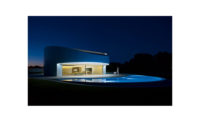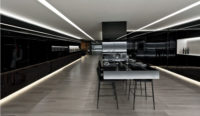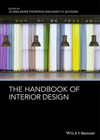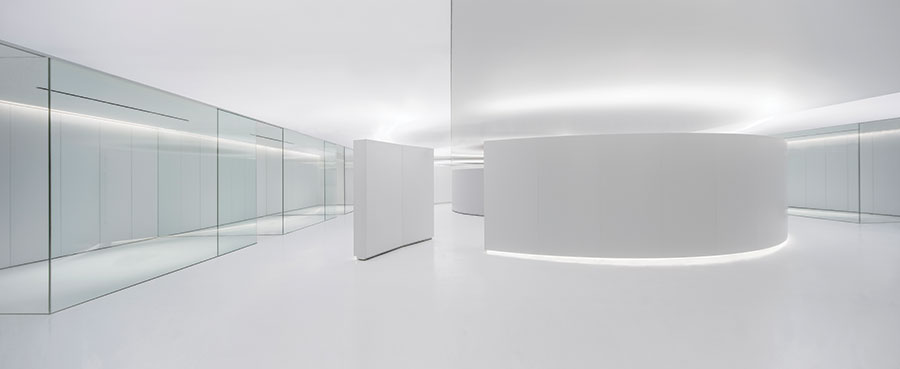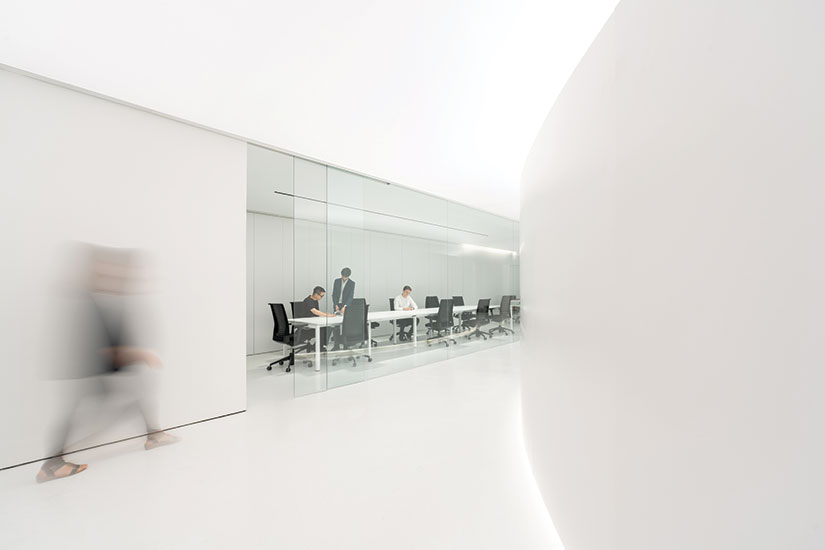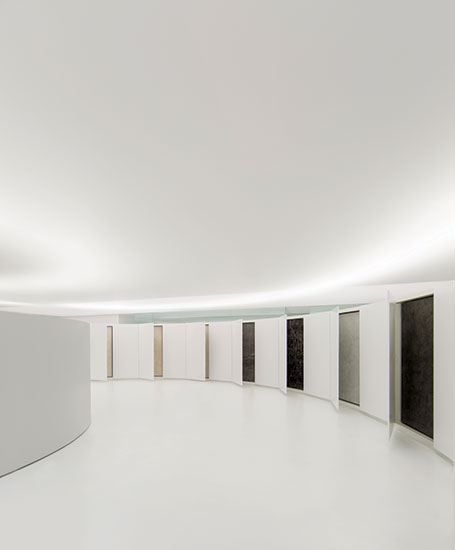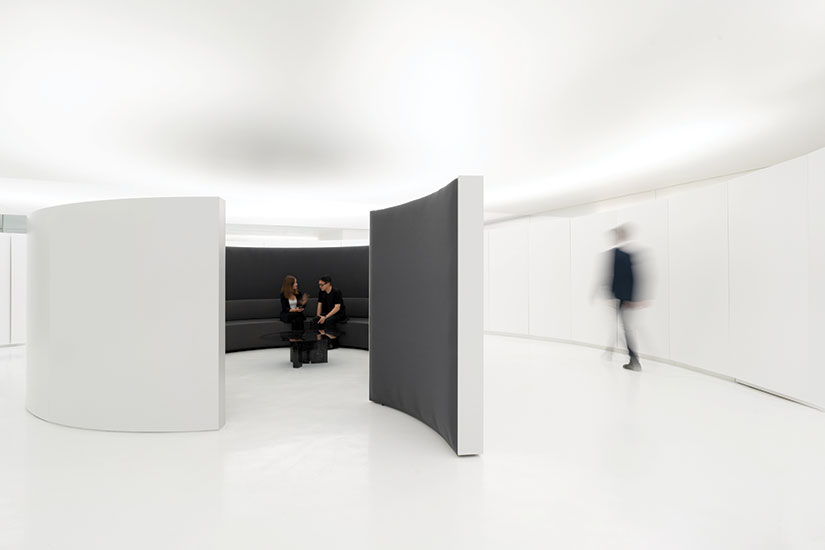Petra, The Stone Atelier by Fran Silvestre Arquitectos
Valencia, Spain

Flanked by glazed offices and conference rooms, the circular wall at the rear of the Petra showroom opens to reveal a secret display area with a smaller ring inside, used for private meetings and business transactions.
Photo © Fran Silvestre Arquitectos

The reception area is clad in stone, leading to glass-enclosed offices.
Photo © Fran Silvestre Arquitectos

The reception area is clad in stone, leading to glass-enclosed offices.
Photo © Fran Silvestre Arquitectos

Stone samples are kept behind flush doors backing the larger ring wall.
Photo © Fran Silvestre Arquitectos

The small meeting room at its core is lined with sound-absorbing fabric and furnished with a stone-based table by Silvestre, part of the Petra collection.
Photo © Fran Silvestre Arquitectos

The small meeting room at its core is lined with sound-absorbing fabric and furnished with a stone-based table by Silvestre, part of the Petra collection.
Photo © Fran Silvestre Arquitectos

Image courtesy Fran Silvestre Arquitectos







Architects & Firms
There are no evident samples on display at Petra, the Stone Atelier, a stone showroom and supplier in Valencia, Spain. Instead, sales associates lead clients to a luminous area at the rear of the minimalist space, where glazed offices and conference rooms on each side flank a 7-foot-high circular wall at its center. But as a segment of this ringlike form pivots open, visitors will discover a secret room lined with a contiguous series of discreet flush doors, each opening to reveal a slab of one of 36 varieties of stone, all organized chromatically from light to dark and evenly illuminated from above. The project’s architect, Valencia-based Fran Silvestre, rejected more conventional display systems such as racks with sliding panels as too much “like a bazaar.” Summing up the client’s upscale marketing strategy, he explains, “The better the product, the less of it you should see on display.”
Additional Content:
Jump to credits & specifications
The journey into the inner sanctum of hidden stone is part of a design calculated to convert the sales process into “an experience” involving a succession of spatial settings. These proceed from the entrance and reception area, through a long, broad corridor to the back, and culminate within the ring, which—like a nesting Matryoshka doll—contains a smaller circular room for private meetings and closing deals. Situated off-center so as not to crowd the space around it (a strategy that also contributes to dynamic circulation patterns), this intimate sphere is upholstered in a black sound-absorbing textile and, at slightly under 6 feet, is just tall enough to prevent a person of average height from easily seeing inside.
The overall sequence builds on the irregular configuration of the 6,870-square-foot showroom. Originally constructed for light industry in the 1950s, its largest section occupies what had been the inner courtyard of a turn-of-the-century apartment building located in a recently revived, fashionable neighborhood. From the entrance on the street, a long corridor tunnels under the building to the former courtyard, with a procession of structural columns down its center that the architect enlarged into regular piers. The diaphanous space that now houses the circular rooms is spanned by a truss-supported roof with skylights. Silvestre mixes daylight with electric light, filtering both through distinct, translucent textile panels set flush in the suspended ceiling. He also eliminated a row of columns, which divided the space, by reinforcing the trusses above.
A pair of substantial entry doors pivot into the foyer’s side walls when this “atelier” is open. These feature gray-veined panels of limestone-like dolomite that can be easily replaced if desired. The only visible stone in the showroom is found just beyond the entrance, where surfaces at the reception desk and a small sitting area between the first two piers are quietly dressed in book-matched dolomite. The remaining finishes, including an epoxy floor, are understated and white so as not to upstage or influence the client’s selection process.
Flush doors reappear along each side of the corridor beyond reception. This is where the company stores its most exotic and expensive samples, such as onyx and semiprecious stones, backlit or mounted on glass—flamboyant appetizers to the more “classic” varieties exhibited within the circle at the rear of the showroom.
Silvestre developed the double rings to maximize the sense of space. From outside, the large one offers an illusion of expansive continuity as it curves out of sight, he says, and, from within, it seems even larger. “They don’t reach the ceiling, so the space feels bigger,” he explains. “Inside, you feel as if you are in another room.” Overhead, uplights around the top edge of the outer ring create a halo effect on the ceiling, encircling an atmospheric shadow cast by the internal ring room, a subtle indication of its dark finishes.
The distilled geometry of Silvestre’s design echoes with metaphoric allusions. At the most basic level, the larger circle is a kind of Stonehenge, and, despite the easy joke of this association, its ring of stone offers, in its own way, a whiff of mysterious, mystic harmonies. A more direct reference for the architect was the plan of Gordon Bunshaft’s Hirshhorn Museum in Washington, D.C. (1967–74), which features a circular drum inside a low-walled square court. Silvestre is fascinated by the space between these two forms and the almost gravitational tension of the circle’s tangential approach toward and retreat from the perimeter of its container, an effect seen at Petra as the large circle nears the rear wall of the space.
The circular figures in the Petra showroom are close to the crisp shapes of abstract geometric art, as in the work of the local sculptor Andreu Alfaro (1929–2012) that is a constant, if indirect, reference for Silvestre. At another extreme, they may recall the exalted geometries of Étienne-Louis Boullée or Claude Nicolas Ledoux. Silvestre’s exquisitely demanding transformation of material and program into spatial form thus engages with some of the eternal visual narratives of architecture without betraying the immediate task at hand, the crafting of a unique marketing venue.
CreditsArchitect: Fran Silvestre Arquitectos
Personnel in architect's firm who should receive special credit: Fran Silvestre, Ricardo Candela, principals in chargel Rubén March, María Masià, Fran Ayala, Estefanía Soriano, Pablo Camarasa, Sandra Insa, Santi Dueña, David Sastre, Sevak Asatrián, Álvaro Olivares, Eduardo Sancho, Esther Sanchis, Vicente Picó, Jose Manuel Arnao, Gemma Aparicio, Rosa Juanes, Giuseppe Felici, Luiz Eduardo Lupatini, Silvia Bonet, Carmen Martí, Sergio Llobregat
Interior designer: Alfaro Hoffman
Engineers: Logicus
Consultants: MG Lighting (lighting Design); Papema (carpentry)
Photographer: Fran Silvestre Arquitectos |
SpecificationsGlazing Montserrat
Black Marble Stonehegen (bathroom)
Furniture Dynamobel; Petra, The Stone Atelier
Lighting iGuzzini (Laser Blade); Enrique Ferre Cofer (fluorescent linear luminaire and LED) |


